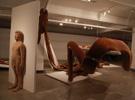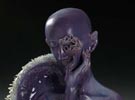The 9 Answers about Into Papers
A:Li Hongjun Q:Jiang Yuehong
Q: What does “art” mean to you?
1A:I have never thought it over before. Well, since you ask it, let me think .Well, once I brought a bunch of my drafts to Professor Yin Ji-nan for his advice in 1991, he had a look of them and encouraged me, besides, he said: “There are two kinds of painters: one kind are those who needn’t paint always; another kind are those who must paint always, I think you are one of those who must paint always”. Since then, I have learnt these courageous words by heard. Whenever my art practice severely twists with my regular routine in career and life, these words will always turn up in my mind. Frankly, I had lived as he said before 1996, feeling quite awful if I had painted nothing. At that time I seemed living aimlessly, easily satisfied if anyone had praised my pieces once, or my pieces were once exhibited or published somewhere. From 1996 to 2006, I didn’t paint, but I did feel very awful. When I look back now, I think it may be affected by my age, the social environment and the issues of my family and working places, etc., at that time. I didn’t find back my past ambition in art practice until I went back to the Central Academy of Art for my postgraduate study. Someone says art is “a belief”, “art is kind of a drug”. I do agree to such a comment for the sake of an artist. I have tasted it, being addicted as well. There is another view saying “art is a kind of profession”. I think it is a recent view only for the last twenty years. Twenty years ago, there were few professional artists in China, and, to a person like me who lingered around between within the state-owned facility system and out of it in society, being a professional artist could be a dream only, as I am a person hard to give up, a desirous fellow. For my career experiences, I have worked as a painter, a farmer, a woodworker, a herbalist doctor, and, at last, lots of lucks have led me to the career I originally enjoyed, allowing me access to the state-supplied grains and the “iron bowl” of the state. Of course the best luck is that the art practice I engage in allows me to express my fantastic ideas freely and independently via my pieces, and maximizes the value of my personal existence, so I feel taking a job in art is very good.
Q: What's the first point when you create a work?
2A:The artisans in the past would first concern the practicability and what the customers wanted before they designed and made a piece. However, since art was separated from life, it began apart from its practicability spiritualizing the objects with certain concepts. The independence of art practices, the extensity of views, the university of media and others bring out changes in art methods. Recently there has been a group of phrases describing the artists’ methods in practice: “one method is to begin with a concept”, which means that a concept comes first, to find material media and languages corresponding to it next, and a piece completed at last. Even though the artist doesn’t know the language of certain material very well, he still can have others make it out and he is only responsible for the concept. “Another method is to start with material”, which means that mastering the language of certain material comes first, based on which searching a corresponding concept follows. This method lets the artists capable of controlling a practice but restricted to the language limit and unable to touch any boundless concepts. Each method gets its own strength. I’m the one with the second method. I think, no matter how an artist develops a method, he shall always use certain material language or specific objects to present his idea. The physical property of language applied in art basically decides the identity of an artist as a workman. The methods I choose enable me not only to control my practice but also to enjoy the charm of spreading the restricted material expression and the pleasure of extending my ideas. The engagement in working out such a complicate production makes me contented and sure inside.
Q: Could you tell us those stories about “paper” ?
3A:The story of Cai Lun’s Invention of Paper-making? It is well-known to everyone. I’m very interested in a story of how Wang Caoji washed paper, which took place in the Chipo Village of the Wenjiapo County in my hometown. Mr. Wang is a strange figure well-known in the town. He is a farmer-born intellect, practicing his skills and cultivating himself spiritually everyday. He is a master of the ancient Yin-Yang theory. “Washing paper” is one of his practices, one way of his personal cultivation which is transformed from the traditional custom of “cherishing paper” by him. Every morning, whenever he gets up, he would carry a basket on his back, go to a primary school and pick up paper, even the papers used for toilet in the school toilets. Those toilet papers are the papers torn off from used exercise books. After the collection, he would go to a river, wash clean those collected papers one after another, and then dry them, flatten them, keep them pressed under the mat on a kang ( a heated brick bed common in North China). Then, he would use them to practice his calligraphy, and in the end burn them out before a shrine. He not only picks up paper himself, moreover, he asks those countrywomen to do so for him in return instead of charging them money whenever they ask him to help their begging lots, asking for an interpretation of divinatory symbols or a medical treatment, seeking any lost object, placing a bed, holding a marriage or selecting a lucky date. I once told the story to Professor Lv Shengzhong and Professor Xu Bin who are both interested in it very much. They both have their insights of it. The methods and spirit borne in the practice of paper-washing have been converted and persistently extended in their works.
Q: What does “paper” mean to you?
4A:Since its invention, paper has always been playing a key role in human culture, as a main carrier for accumulation and communication of human knowledge. As for myself, it is when I was tied up to a kang inside a residential cave as a baby that I first got known of paper. The cave window was checked in the Tang-dynasty style, where the cases are pasted with a thin snow-white paper.It is the only place allowing the lights through into the cave in the daytime. On each case were pasted some red paper-cuts shapes as cats, dogs, flowers and bushes. There were two cases made on the top for air through, where the paper gourds were pasted and keep on revolving. The two revolving gourds were the only moving objects before my eyes at that time. When it was in winter before every lunar December 23, the paper over the whole window would turn yellow and broken and the North wind blowing up would cause some loud voices, pretty shocking. My mum would use her headbands or movable sleeves to block those holes. On the right day of every lunar December 23, as scheduled, my mum would change a new snow-white paper and decorate it elaborately.
During my primary schooling, I got to paper fairly often. Like other kids, I also used certain used exercise papers wiping my ass. When I started learning how to paint, I just bought paper priced 4 cent per piece. The village store only sold the kind. In 1976, when I took part in the Educational Exhibition of Class Struggles, I first got known of newsprint, watercolor paper and sketch paper for painting. When I got these kinds of paper at that time, I even didn’t dare to paint easily on them. It is in 1985 when I was in charge of collecting folk paper-cuts in the local culture hall that I started learning about paper. The abundant patterns of paper-cuts and the steely traces cut by the scissors through a paper did make me excited always. When I got to those artisans who made paper flowers and paper lamps, I really felt it amazing in watching those colorful papers being folded, plucked, pressed and pasted into a lifelike lotus leaf or peony leaf. In 1987, I went to Central Academy of Art for my advanced study. The first lesson is on paper-cuts lectured by Professor Lv Shengzhong– what is odd-cutting, folding, exchanging, shaping in positive & negative, coloring, etc. Professor Lv led me into the shaping and language system of Chinese paper-cutting art, altering the viewpoint and depth of my learning about it. Under his instruction, I wrote a book about the skills of paper-cutting, which is also my first work about paper. In 2006 when I took my postgraduate study, I started interested in wood and farm implements (synthesis material) very much; however, after a serious consideration, I decided to choose paper that I am familiar with as my medium. I think that it is still certain possible for us to keep on digging out the value of paper as traditional material for art , and to combine paper as the traditional material with the modern computer technology will place a far-reaching influence on materialization of paper property. From the view of the art practices today, I think my choice of paper suits me relatively.




